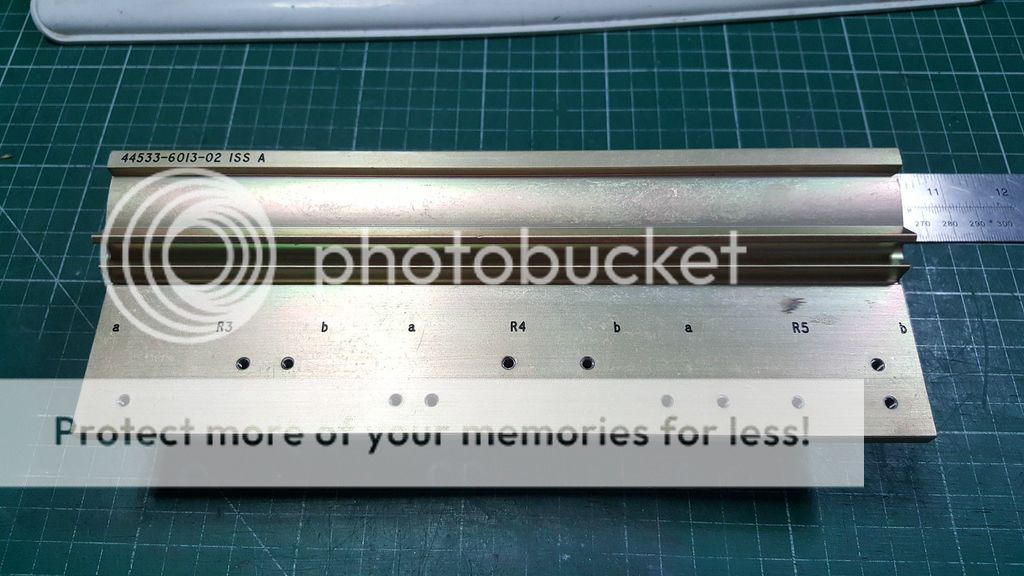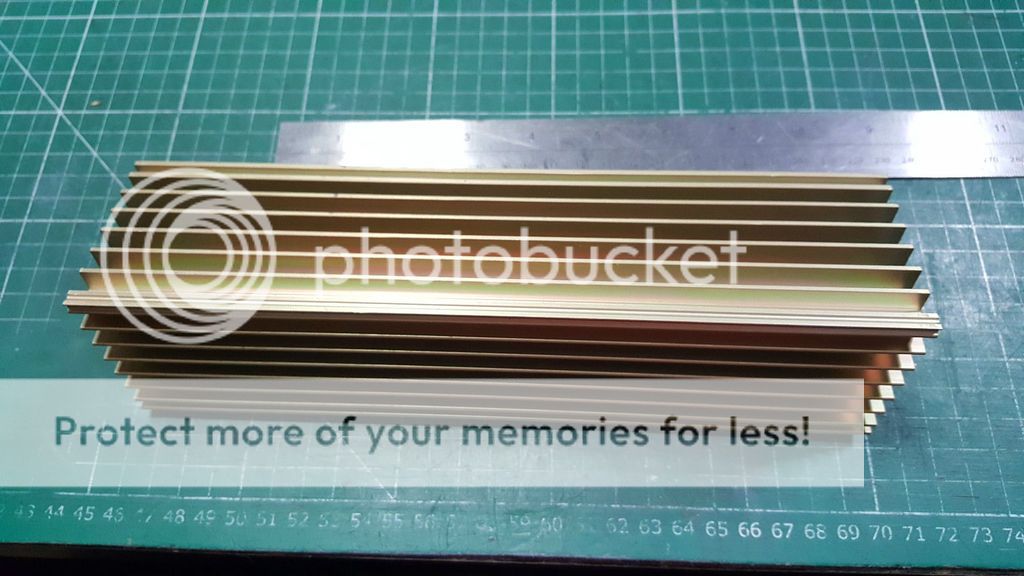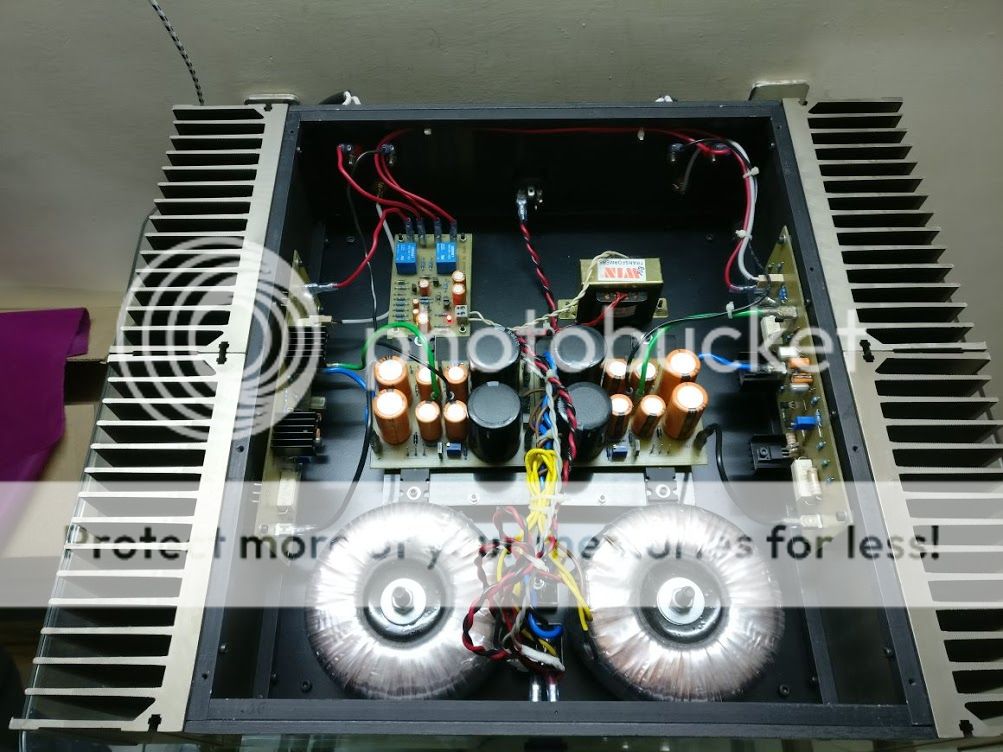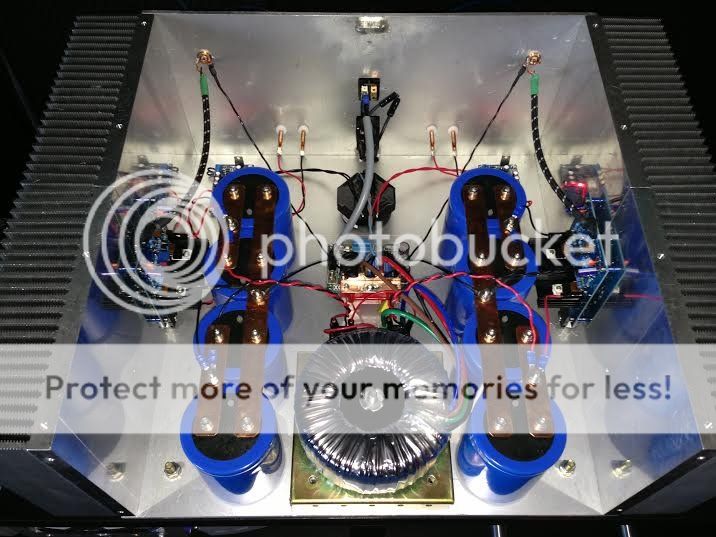Hi All
So after a great deal of thought and advice i decided it's time to build this wonderful Amplifier.
This will be my first build and i will be learning as i go along, i am hoping many of you on here will be able to help and guide me.
I have read most of the threads on different websites to get me started, but as you can imagine i still have some queries especially with concerns for the power supply and output transistors.
I've ordered this kit from Jims Audio:
Hiraga super 30W class A w/ current source + kubota reg partial assembled kit ! | eBay
This one being with the Kubota regulator.

These are my heatsinks from a military plane cockpit console.



I realise i need more and i will be machining some add on designed heatsinks to these, i will be also be making and designing my own custom enclosure.
Where i am stuck now is the output transistors and the PSU.
to be on the safe side i ordered these from Jims Audio to just test them.
On Semi MJL4281A MJL4302A matched quad 2%
https://www.onsemi.com/pub/Collateral/MJL4281A-D.PDF
Whats other builders experience on output transistors? Any suggestions?
So far my research has shown these to be popular.
1. Exicon 10N20 10P20 Audio Mosfet TO3P TO247 ECX10P20R ECX10N20R
EXICON - Lateral MOSFET | Profusion
2. Sanken 2SA922/2SA1216
https://www.digikey.com/product-detail/en/sanken/2SA1216/2SA1216-ND/3661801
3. Sanken 2sc3264/2sa1295
2SC3264 ALLEGRO SANKEN, Bipolar (BJT) Single Transistor, NPN, 230 V, 60 MHz, 200 W, 17 A, 50 hFE | Farnell element14
4. MJL0281/MJL3281
Interested if people have used any of these and the results they got.
Now here is where i have a dilemma, its the power supply. I don't even know where to start.
Whats the thoughts on SMPS? is it possible? Anyone here done it with a class A? Would it work?
I've seen so many different designs: Please see pics below.



Check this video out
https://www.youtube.com/watch?v=2OYE7zFONtU
i mean look those bank of capacitors?
Lets start with the Transformer, i can either use Torodial or EI.
I was thinking two separate transformers 400va each rail voltage of 24-0-24?
Thoughts on this?
Then i thought i could use a power rectifier board: one for each channel
Douk Audio 6*10000UF/50V Hi-Fi Amplifier Power Supply Board with Speaker Protect | eBay
Power rectifier board 6x NOVER Auido 10000uf 50V power supply PSU for amplifier | eBay
Would i still need some hefty capacitors before these?
im guessing i need a soft start delay aswell?
Class A Power Amplifier Soft Start Delay Temperature Protection Board 220V 30A
Or would i just go traditional PSU? A hefty transformer 1.2f capacitors and some heavy duty rectifiers?
I don't want to suffer from noise or interference, i do want the amplifier to sound sweet with good mids and bass.
Thats the only thing confusing me at the moment, is what Power supply should be.
So any advice you may have please throw it my way!
So after a great deal of thought and advice i decided it's time to build this wonderful Amplifier.
This will be my first build and i will be learning as i go along, i am hoping many of you on here will be able to help and guide me.
I have read most of the threads on different websites to get me started, but as you can imagine i still have some queries especially with concerns for the power supply and output transistors.
I've ordered this kit from Jims Audio:
Hiraga super 30W class A w/ current source + kubota reg partial assembled kit ! | eBay
This one being with the Kubota regulator.

These are my heatsinks from a military plane cockpit console.



I realise i need more and i will be machining some add on designed heatsinks to these, i will be also be making and designing my own custom enclosure.
Where i am stuck now is the output transistors and the PSU.
to be on the safe side i ordered these from Jims Audio to just test them.
On Semi MJL4281A MJL4302A matched quad 2%
https://www.onsemi.com/pub/Collateral/MJL4281A-D.PDF
Whats other builders experience on output transistors? Any suggestions?
So far my research has shown these to be popular.
1. Exicon 10N20 10P20 Audio Mosfet TO3P TO247 ECX10P20R ECX10N20R
EXICON - Lateral MOSFET | Profusion
2. Sanken 2SA922/2SA1216
https://www.digikey.com/product-detail/en/sanken/2SA1216/2SA1216-ND/3661801
3. Sanken 2sc3264/2sa1295
2SC3264 ALLEGRO SANKEN, Bipolar (BJT) Single Transistor, NPN, 230 V, 60 MHz, 200 W, 17 A, 50 hFE | Farnell element14
4. MJL0281/MJL3281
Interested if people have used any of these and the results they got.
Now here is where i have a dilemma, its the power supply. I don't even know where to start.
Whats the thoughts on SMPS? is it possible? Anyone here done it with a class A? Would it work?
I've seen so many different designs: Please see pics below.



Check this video out
https://www.youtube.com/watch?v=2OYE7zFONtU
i mean look those bank of capacitors?
Lets start with the Transformer, i can either use Torodial or EI.
I was thinking two separate transformers 400va each rail voltage of 24-0-24?
Thoughts on this?
Then i thought i could use a power rectifier board: one for each channel
Douk Audio 6*10000UF/50V Hi-Fi Amplifier Power Supply Board with Speaker Protect | eBay
Power rectifier board 6x NOVER Auido 10000uf 50V power supply PSU for amplifier | eBay
Would i still need some hefty capacitors before these?
im guessing i need a soft start delay aswell?
Class A Power Amplifier Soft Start Delay Temperature Protection Board 220V 30A
Or would i just go traditional PSU? A hefty transformer 1.2f capacitors and some heavy duty rectifiers?
I don't want to suffer from noise or interference, i do want the amplifier to sound sweet with good mids and bass.
Thats the only thing confusing me at the moment, is what Power supply should be.
So any advice you may have please throw it my way!
Last edited:
Congratulations on your purchase! Jim's boards and components are pretty decent. I built mono blocks using his Le Monstre kit.
You are talking about building a huge power supply at over 1F of capacitance. Even Hiraga, who designed the Class A over 30 years ago, didn't spec. that much. He used 6 x 60,000 uF, which might be even be considered excessive today. You should look over some of the Pass amp PS schematics, which will give you a good framework in terms of capacitance size, filtering and wiring. Cap multipliers are another way to reduce ripple with an unregulated power supply. Regulated supplies are a whole other subject...
As far as the transformer goes, I'm not sure what the logic behind using two is. It appears you have a stereo board. Normally two transformers are used when you have two separate amp boards, PSUs, rectifiers, etc. to ensure channel separation. Most of the high-end power amps use toroidals. SMPS have been used successfully in power amps, but have a number of drawbacks, the biggest one of which is noise.
If you haven't yet read through the Class A info on the Hiraga Class A 20w, you should definitely review it. The Class-A Amplifier Site - Jean Hiraga Index
You are talking about building a huge power supply at over 1F of capacitance. Even Hiraga, who designed the Class A over 30 years ago, didn't spec. that much. He used 6 x 60,000 uF, which might be even be considered excessive today. You should look over some of the Pass amp PS schematics, which will give you a good framework in terms of capacitance size, filtering and wiring. Cap multipliers are another way to reduce ripple with an unregulated power supply. Regulated supplies are a whole other subject...
As far as the transformer goes, I'm not sure what the logic behind using two is. It appears you have a stereo board. Normally two transformers are used when you have two separate amp boards, PSUs, rectifiers, etc. to ensure channel separation. Most of the high-end power amps use toroidals. SMPS have been used successfully in power amps, but have a number of drawbacks, the biggest one of which is noise.
If you haven't yet read through the Class A info on the Hiraga Class A 20w, you should definitely review it. The Class-A Amplifier Site - Jean Hiraga Index
Hi, regards the power supply. For class A I would advise SMPS. There is plenty of evidence that it can work very well. I suspect a linear supply is often used with class A because it fits with the old world minimalist charm of the design, not because it functions any better. It would weigh a lot and cost a lot and have lots of huge capacitors to impress people who like that sort of thing. A regulated supply also works better with class A than AB because of the constant load presented by the amp.
SMPS power
Well SMPS for this particular build would be going against the grain, i have yet to find a diyer who has done it. I might give it try scott, any recommendations?
http://www.ebay.co.uk/itm/RS-Pro-96...890612?hash=item2a7f91d6f4:g:0I0AAOSw03lY75Bd
Hi, regards the power supply. For class A I would advise SMPS. There is plenty of evidence that it can work very well. I suspect a linear supply is often used with class A because it fits with the old world minimalist charm of the design, not because it functions any better. It would weigh a lot and cost a lot and have lots of huge capacitors to impress people who like that sort of thing. A regulated supply also works better with class A than AB because of the constant load presented by the amp.
Well SMPS for this particular build would be going against the grain, i have yet to find a diyer who has done it. I might give it try scott, any recommendations?
http://www.ebay.co.uk/itm/RS-Pro-96...890612?hash=item2a7f91d6f4:g:0I0AAOSw03lY75Bd
Last edited:
Did I mention the JLH thread re people using SMPS? I haven't used them myself but have read here and elsewhere about people using them. This is a good thread http://www.diyaudio.com/forums/solid-state/231375-smps-powered-jlh-69-quick-dirty-results-3.html
Your link takes me to a 40A power supply?? How many amps are you planning to build?

Your link takes me to a 40A power supply?? How many amps are you planning to build?
Last edited:
Did I mention the JLH thread re people using SMPS? I haven't used them myself but have read here and elsewhere about people using them. This is a good thread http://www.diyaudio.com/forums/solid-state/231375-smps-powered-jlh-69-quick-dirty-results-3.html
yes i read this thread, still need more information though.
Have you tried PMing people who have used them? Or you could start another thread
hahaha well considering the technology you would think people would be trying it. I'm going to try a 960w 40A 24v SMPS see what it does.
Last edited:
more power!
Why not? just to be on the safe side. That should be more than enough to power two amp boards? Plus i can offer him a price and get it cheaper.
just to be on the safe side. That should be more than enough to power two amp boards? Plus i can offer him a price and get it cheaper.
I mean there is lots of choice?
http://www.ebay.co.uk/itm/High-qual...964483?hash=item3f6adf6343:g:5QkAAOSwAuZX2Stj
if i choose one i would want good quality with high power.
See my edit above. Why do you need 40A?
Why not?
I mean there is lots of choice?
http://www.ebay.co.uk/itm/High-qual...964483?hash=item3f6adf6343:g:5QkAAOSwAuZX2Stj
if i choose one i would want good quality with high power.
Last edited:
I suppose it might come in handy when you decide to go active and tri-amp your system and add subwoofers......
That one you linked to looks like its only single rail, so you'd need two
Yes the other link was a smaller unit, i gathered i would need two.
Hence why i thought buy a massive 960w 40a unit then i can power both of the amp boards off one power supply.
Hence why i thought buy a massive 960w 40a unit then i can power both of the amp boards off one power supply.
No, I meant it looks like it's a single rail supply, you need dual rail +/- to power your amp
Hi, regards the power supply. For class A I would advise SMPS. There is plenty of evidence that it can work very well. I suspect a linear supply is often used with class A because it fits with the old world minimalist charm of the design, not because it functions any better. It would weigh a lot and cost a lot and have lots of huge capacitors to impress people who like that sort of thing. A regulated supply also works better with class A than AB because of the constant load presented by the amp.
When suggesting that a SMPS is regulated, you are wrong. They are not regulated by definition.
I'd say that regulated supplies work better with amplifiers not presenting a constant load (to prevent voltage sag under dynamic conditions).
Unregulated power supplies and class A go together perfectly when executed well.
When suggesting that a SMPS is regulated, you are wrong.
Maybe I should have started another paragraph, I can see how it read like that, but that isn't what I meant
I'd say that regulated supplies work better with amplifiers not presenting a constant load (to prevent voltage sag under dynamic conditions).
From my understanding, this is wrong, here is a good explanation as to why Solid State Power Amplifier Supply Part 1
Apparently you did not read it well enough; to quote:
"....So, to wrap up - full voltage regulation should be applied to all stages of a power amplifier except the driver and final output stages, which for the sake of dynamics, especially into difficult loads, and economy, should be kept on capacitor smoothed supplies......"
Voltage regulation is good practice in gain stages of power amps, and has been done in the better quality commercial amps.
To do it in output stages you would need a very fast regulated supply, being actually another amp (also stated in your link).
"....So, to wrap up - full voltage regulation should be applied to all stages of a power amplifier except the driver and final output stages, which for the sake of dynamics, especially into difficult loads, and economy, should be kept on capacitor smoothed supplies......"
Voltage regulation is good practice in gain stages of power amps, and has been done in the better quality commercial amps.
To do it in output stages you would need a very fast regulated supply, being actually another amp (also stated in your link).
I'd say that regulated supplies work better with amplifiers not presenting a constant load (to prevent voltage sag under dynamic conditions).
So above, you mean the gain stages only?
- Home
- Amplifiers
- Solid State
- Jean Hiraga Super Class A 30w Build